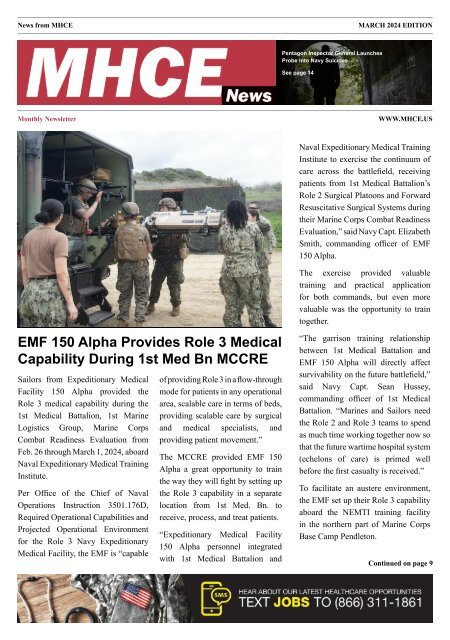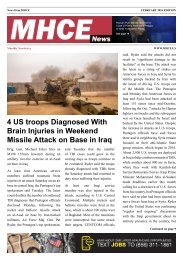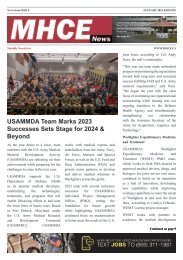MHCE MARCH 2024
Create successful ePaper yourself
Turn your PDF publications into a flip-book with our unique Google optimized e-Paper software.
News from <strong>MHCE</strong><br />
<strong>MARCH</strong> <strong>2024</strong> EDITION<br />
Pentagon Inspector General Launches<br />
Probe Into Navy Suicides<br />
See page 14<br />
Monthly Newsletter<br />
WWW.<strong>MHCE</strong>.US<br />
Naval Expeditionary Medical Training<br />
Institute to exercise the continuum of<br />
care across the battlefield, receiving<br />
patients from 1st Medical Battalion’s<br />
Role 2 Surgical Platoons and Forward<br />
Resuscitative Surgical Systems during<br />
their Marine Corps Combat Readiness<br />
Evaluation,” said Navy Capt. Elizabeth<br />
Smith, commanding officer of EMF<br />
150 Alpha.<br />
The exercise provided valuable<br />
training and practical application<br />
for both commands, but even more<br />
valuable was the opportunity to train<br />
together.<br />
EMF 150 Alpha Provides Role 3 Medical<br />
Capability During 1st Med Bn MCCRE<br />
Sailors from Expeditionary Medical<br />
Facility 150 Alpha provided the<br />
Role 3 medical capability during the<br />
1st Medical Battalion, 1st Marine<br />
Logistics Group, Marine Corps<br />
Combat Readiness Evaluation from<br />
Feb. 26 through March 1, <strong>2024</strong>, aboard<br />
Naval Expeditionary Medical Training<br />
Institute.<br />
Per Office of the Chief of Naval<br />
Operations Instruction 3501.176D,<br />
Required Operational Capabilities and<br />
Projected Operational Environment<br />
for the Role 3 Navy Expeditionary<br />
Medical Facility, the EMF is “capable<br />
of providing Role 3 in a flow-through<br />
mode for patients in any operational<br />
area, scalable care in terms of beds,<br />
providing scalable care by surgical<br />
and medical specialists, and<br />
providing patient movement.”<br />
The MCCRE provided EMF 150<br />
Alpha a great opportunity to train<br />
the way they will fight by setting up<br />
the Role 3 capability in a separate<br />
location from 1st Med. Bn. to<br />
receive, process, and treat patients.<br />
“Expeditionary Medical Facility<br />
150 Alpha personnel integrated<br />
with 1st Medical Battalion and<br />
“The garrison training relationship<br />
between 1st Medical Battalion and<br />
EMF 150 Alpha will directly affect<br />
survivability on the future battlefield,”<br />
said Navy Capt. Sean Hussey,<br />
commanding officer of 1st Medical<br />
Battalion. “Marines and Sailors need<br />
the Role 2 and Role 3 teams to spend<br />
as much time working together now so<br />
that the future wartime hospital system<br />
(echelons of care) is primed well<br />
before the first casualty is received.”<br />
To facilitate an austere environment,<br />
the EMF set up their Role 3 capability<br />
aboard the NEMTI training facility<br />
in the northern part of Marine Corps<br />
Base Camp Pendleton.<br />
Continued on page 9
2 | <strong>MHCE</strong> - News www.mhce.us <strong>MARCH</strong> <strong>2024</strong> EDITION WWW.<strong>MHCE</strong>.US<br />
Monthly Newsletter | 3<br />
2023 Reentry Recap: Program Success at CoreCivic<br />
Research shows that general education and vocational training programs are critical to preparing<br />
justice-involved individuals for a successful reentry. From day one, those in our care are individually<br />
assessed to determine which tools, resources, and programs are best to adequately support their<br />
rehabilitation needs.<br />
CoreCivic is helping pave<br />
the way to a brighter future<br />
for those in our care by<br />
providing evidence-based<br />
reentry programming.<br />
Take a look at some of<br />
the reentry programming<br />
progress at CoreCivic in<br />
2023.
4 | <strong>MHCE</strong> - News www.mhce.us <strong>MARCH</strong> <strong>2024</strong> EDITION WWW.<strong>MHCE</strong>.US<br />
Monthly Newsletter | 5<br />
TOWER HEALTH IS HIRING<br />
PHYSICIANS AND ADVANCED PRACTITIONERS<br />
Join One of the Nation’s Top 1% Hospitals<br />
It takes great physicians committed to providing the highest quality healthcare that meets<br />
the most stringent patient guidelines to rank a hospital in the top 1% of hospitals nationwide<br />
(source: Healthgrades). Reading Hospital – the flagship of Tower Health – is a recipient of<br />
Healthgrades® America’s 50 Best Hospitals Award. Tower Health is comprised of four<br />
hospitals that span three counties and service almost 2.5 million people in Southeastern PA,<br />
just 90 minutes from Philadelphia. Ready to explore these outstanding opportunities? Forward<br />
your CV for immediate and confidential review to medicalstaffrecruitment@towerhealth.org<br />
Scan the QR Code or<br />
go to Careers.TowerHealth.org<br />
to explore opportunities!<br />
Tower Health is an Equal Opportunity Employer committed to creating a diverse and inclusive environment reflective of the communities we serve.
6 | <strong>MHCE</strong> - News www.mhce.us <strong>MARCH</strong> <strong>2024</strong> EDITION WWW.<strong>MHCE</strong>.US<br />
Monthly Newsletter | 7
8 | <strong>MHCE</strong> - News www.mhce.us <strong>MARCH</strong> <strong>2024</strong> EDITION WWW.<strong>MHCE</strong>.US<br />
Monthly Newsletter | 9<br />
“NEMTI’s mission is to<br />
ensure readiness of our<br />
medical personnel to support<br />
the warfighter in austere<br />
environments through<br />
partnerships across Navy<br />
/ Marine Corps medical<br />
platforms. These events<br />
are crucial in providing<br />
an opportunity to exercise<br />
those partnerships and “train<br />
like we fight” with complete<br />
integration of Navy and<br />
Marine Corps medical<br />
personnel simulating real<br />
world operations and the<br />
roles of care,” said Cmdr.<br />
Damian Storz, NEMTI’s<br />
officer in charge.<br />
“Our<br />
continued<br />
collaboration with NEMTI<br />
allowed us to utilize their<br />
pre-positioned EMF tents,<br />
equipment, and subject<br />
matter experts to maximize<br />
our Role 3 capability,”<br />
said Navy Capt. Adolfo<br />
Granados, executive officer<br />
of EMF 150 Alpha. “This<br />
was impactful because we<br />
were in the field dealing with<br />
conditions similar to real<br />
world situations, honing our<br />
skills as an expeditionary<br />
unit.”v<br />
The EMF team obtained<br />
great, realistic training<br />
and experience during the<br />
evolution that will pay<br />
dividends in the event they<br />
must deploy in support of<br />
contingency operations.<br />
“We were able to evaluate<br />
Mission Essential Tasks<br />
such as command and<br />
control, patient movement, patient<br />
tracking, and casualty receiving. We also<br />
field tested the use of Battlefield Assisted<br />
Trauma Distributed Observation Kits<br />
(BATDOKs) that allow medical personnel<br />
to monitor patient’s vitals wirelessly,<br />
from point of injury, autonomously<br />
document patient care and transmit data<br />
throughout the patient’s continuum of<br />
care,” added Smith. “These exercises<br />
continue to demonstrate interoperability<br />
and warfighting readiness across the<br />
Navy and Marine Corps team.”<br />
The EMF team was kept busy each<br />
training day with a steady throughput<br />
of simulated casualties to maintain<br />
the operational tempo of a combat<br />
environment.<br />
“Over the course of the MCCRE, EMF<br />
150 Alpha received, treated, tracked,<br />
and medically evacuated 76 patients,”<br />
said Lt. Jg. Amber Campaign, EMF 150<br />
Alpha’s acting operations officer.<br />
The exercise offered the opportunity to<br />
try out some state-of-the-art, emerging<br />
equipment on the simulated battlefield.<br />
“We employed medical battlefield<br />
technology new to the Navy in the form<br />
of the BATDOKs. This is a promising<br />
tool for battlefield medical documentation<br />
and communication throughout the care<br />
continuum,” added Granados. “We will<br />
provide feedback to Naval Medical Forces<br />
Pacific about their applicability and<br />
functionality.”<br />
Taking advantage of an opportunity to<br />
include a Role 3 capability during 1st Med.<br />
Battalion’s MCCRE was indicative of<br />
similar operationally focused mindsets in<br />
both commanding officers where combat<br />
readiness is paramount.
10 | <strong>MHCE</strong> - News www.mhce.us <strong>MARCH</strong> <strong>2024</strong> EDITION WWW.<strong>MHCE</strong>.US<br />
Monthly Newsletter | 11<br />
None of the American forces will<br />
Hamas militants’ surprise assault on<br />
It was not clear Friday how much<br />
enter Gaza at any time, including to<br />
Israelis on Oct. 7.<br />
the new aid operations would cost<br />
deliver aid or build the temporary<br />
pier, he said at the Pentagon. Ryder<br />
said the pier should be operational<br />
within about 60 days.<br />
Humanitarian aid has been slow<br />
getting into Gaza for reasons<br />
including blockades at land crossings<br />
and tight controls of aid trucks by<br />
U.S. taxpayers, Ryder said.<br />
The Navy will deploy the floating<br />
pier and causeway toward Gaza via<br />
ships, and soldiers and sailors will<br />
“We’re working to set this up as<br />
Israel, which has accused Hamas of<br />
prepare them for use, Ryder said.<br />
quickly as possible, but we expect<br />
stealing humanitarian goods.<br />
Commercial vessels will be able to<br />
1,000 US Troops<br />
Will Deploy for<br />
Temporary Port<br />
Operations to<br />
Move Aid into<br />
Gaza<br />
The Pentagon will soon deploy<br />
about 1,000 American troops to<br />
build a temporary seaport just off the<br />
coast of war-torn Gaza to provide<br />
its inhabitants some 2 million meals<br />
per day, a Defense Department<br />
spokesman said Friday.<br />
The American troops will deploy a<br />
floating pier and a roughly 1,800-foot<br />
causeway in the Mediterranean Sea<br />
off Gaza’s coast, where commercial<br />
vessels can dock and offload aid to<br />
be transported by smaller vessels<br />
and vehicles into Gaza, said Air<br />
Force Maj. Gen. Pat Ryder, the<br />
Pentagon’s top spokesman.<br />
The operation will use a makeshift<br />
dock known as a Joint Logistics<br />
Over-the-Shore, or JLOTS, and<br />
include Navy and Army personnel,<br />
Ryder said.<br />
that it will take several weeks to<br />
plan and execute,” he said. “Once<br />
operational the actual amount of<br />
aid delivered will depend on many<br />
variables and will likely scale over<br />
time. However, we expect that<br />
deliveries via JLOTS could provide<br />
more than 2 million meals to the<br />
citizens of Gaza per day.”<br />
Not all the forces to be used in the<br />
operation had been selected as of<br />
Friday, Ryder said. However, the<br />
Army’s 7th Transportation Brigade<br />
based at Joint Base Langley-Eustis<br />
in Virginia had already been notified<br />
it would be deployed, he said. That<br />
unit is described by the Army as its<br />
JLOTS experts.<br />
President Joe Biden announced<br />
Thursday during his State of the<br />
Union speech that he ordered the<br />
Pentagon to conduct the new aid<br />
mission. He also called on Israel<br />
to do more to protect civilians and<br />
ensure they receive humanitarian aid<br />
as the Israelis fight Hamas militants<br />
in the Palestinian enclave.<br />
The U.N. said the roughly 2.3<br />
million people in Gaza now face<br />
near-famine conditions amid the<br />
fighting launched in the wake of<br />
The United States in recent days<br />
has begun airdropping some<br />
humanitarian aid into Gazavia<br />
Air Force C-130s. The U.S. and<br />
Jordanian militaries airdropped<br />
about 11,500 meals into northern<br />
Gaza on Friday, according to U.S.<br />
Central Command, which oversees<br />
American military operations in the<br />
Middle East. To date, the United<br />
States has airdropped about 124,000<br />
meals to Gazans, Ryder said.<br />
He also said the U.S. would continue<br />
to press Israel to allow more<br />
humanitarian aid into Gaza via land<br />
crossings, but it would continue to<br />
work to find creative ways to get<br />
meals to the enclave’s civilians.<br />
“This is part of a full-court press<br />
by the United States to not only<br />
focus on working on opening up<br />
and expanding routes via land —<br />
which of course are the optimal way<br />
to get aid into Gaza — but also by<br />
conducting air drops, and now, as the<br />
president has said, not enough aid is<br />
getting in, and so this is a capability<br />
that we have [and] it’s a capability<br />
that we are going to execute,” the<br />
general said.<br />
dock at the floating pier, where their<br />
cargo can be offloaded and reloaded<br />
onto smaller Navy logistics support<br />
vessels, he said.<br />
Those Navy ships will then deliver<br />
the aid onto the causeway, where it<br />
will be loaded onto trucks that will<br />
drive it onto the beach in Gaza for<br />
delivery, Ryder said.<br />
The aid will be driven into Gaza<br />
by vetted U.S. partners and not<br />
American troops, he said. The U.S.<br />
was in talks with partner nations,<br />
nongovernmental organizations and<br />
Israel about who would conduct<br />
those operations.<br />
“The concept that is being planned<br />
involves the presence of U.S.<br />
military personnel on military<br />
vessels offshore but does not<br />
require U.S. military personnel to<br />
go ashore,” Ryder said.<br />
He said the U.S. military would work<br />
to ensure proper security measures<br />
were in place on the ground and<br />
would take precautions to protect<br />
its troops offshore. He declined to<br />
provide specifics about such plans<br />
to protect American forces.
12 | <strong>MHCE</strong> - News www.mhce.us <strong>MARCH</strong> <strong>2024</strong> EDITION WWW.<strong>MHCE</strong>.US<br />
Monthly Newsletter | 13<br />
MILITARY HEROES<br />
WE WANT YOU TO JOIN CENTURION HEALTH AND CONTINUE TO SERVE<br />
When you joined the military, you dedicated your life<br />
to serving our country. At Centurion Health, we<br />
dedicate our lives to transforming the health of the<br />
communities we serve, one patient at a time.<br />
CONTINUE YOUR MISSION OF<br />
SERVICE WITH A TRANSITION INTO<br />
CORRECTIONAL HEALTHCARE<br />
Centurion is actively recruiting for the following positions<br />
Registered Nurses<br />
LPNs<br />
Mental Health Professionals<br />
Psychologists<br />
Psychiatrists<br />
Primary Care Physicians<br />
Dentists<br />
and additional healthcare disciplines<br />
BENEFITS<br />
•Controlled environment with a te am<br />
approach<br />
•Clinically diverse population<br />
•Structured and systematic approach to<br />
processes and proced ure s<br />
•No RVU’s, no billing, and no insurance<br />
hassle s<br />
•Competitive, guaranteed s alaries and<br />
comprehensive benefits<br />
•Company paid malpractice insurance<br />
CAREERS AVAILABLE NATIONWIDE<br />
John Lay, MD<br />
LTC(R), US Army<br />
Statewide Medical Director,<br />
Florida<br />
Practicing medicine in the military is similar to corrections as both<br />
provide evidence-based patient care to a unique population within a<br />
policy focused framework. My experience as a military physician provided<br />
for a smooth transition into a challenging and rewarding second career<br />
as a correctional healthcare physician.<br />
For more information, contact: Teffany Dowdy<br />
770.594.1444 | teffany@teamcenturion.com<br />
CenturionJobs.com | Equal Opportunity Employer<br />
www.CenturionJobs.com | Equal Opportunity Employer
14 | <strong>MHCE</strong> - News www.mhce.us <strong>MARCH</strong> <strong>2024</strong> EDITION WWW.<strong>MHCE</strong>.US<br />
Monthly Newsletter | 15<br />
Pentagon Inspector General Launches Probe Into<br />
Navy Suicides<br />
The Defense Department inspector general is sending<br />
investigators to several Navy installations to evaluate<br />
suicide rates, the Pentagon confirmed Thursday.<br />
Site visits are planned for Naval Base Kitsap in<br />
Washington, Naval Base San Diego, Naval Station<br />
Pearl Harbor in Hawaii, and Naval Air Station<br />
Norfolk in Virginia, according to a memo about<br />
the review. It will also look at suicides and suicide<br />
attempts on ships at sea. Dates for inspections at<br />
each facility have not been announced.<br />
The Pentagon said investigators could visit additional<br />
installations as the review moves forward. The<br />
timing and scope of the review will not be released<br />
in advance.<br />
The suicide review was mandated in the 2023<br />
National Defense Authorization Act, which sets<br />
policy and spending priorities for the Pentagon.<br />
The Navy has reported an increase in suicides and<br />
suicide attempts in recent years, with 71 suicides by<br />
active-duty sailors in 2022. The service reported 65<br />
suicides in 2020 and 59 in 2021. Final statistics for<br />
2023 are not yet available.<br />
Suicide rates differ because of fluctuations in the<br />
number of Navy personnel each year. The rate per<br />
100,000 active-duty sailors was 20.6 in 2022, 17 in<br />
2021 and 19 in 2020, according to the Pentagon’s<br />
2022 annual report on suicide in the military.<br />
A federal study in 2021 found 30,177 active-duty<br />
personnel and veterans in all service branches who<br />
served in the military died from suicide in the 20<br />
years after the 9/11 terrorist attacks. It was more than<br />
four times higher than the 7,057 service members<br />
killed in combat during the same time.<br />
The review will “determine whether the Department<br />
of Navy effectively took actions to prevent and<br />
respond to incidents of deaths by suicide, suicide<br />
attempts and suicidal ideation among members<br />
of the Navy assigned to sea duty or shore duty,”<br />
according to a Feb. 27 memo from the inspector<br />
general’s office.
16 | <strong>MHCE</strong> - News www.mhce.us <strong>MARCH</strong> <strong>2024</strong> EDITION WWW.<strong>MHCE</strong>.US<br />
Monthly Newsletter | 17<br />
Importance of Cyber Warfare a Key<br />
Takeaway From This Year’s Cobra Gold,<br />
General Says<br />
RAYONG, Thailand — Thousands of<br />
troops from 30 nations started for home<br />
Friday as the largest military exercise in<br />
mainland Asia officially came to a close.<br />
More than 9,000 service members from<br />
30 countries — including 4,500 troops<br />
from the U.S. Army, Navy, Air Force and<br />
Marine Corps — gathered throughout<br />
Thailand beginning Feb. 27 for Cobra<br />
Gold, the world’s longest-running annual<br />
exercise of its kind.<br />
Over nearly two weeks, those troops made<br />
amphibious assaults and airborne drops,<br />
fired live artillery rounds, trained for<br />
jungle survival and took part in community<br />
relations projects and other activities.<br />
Lt. Col. Lindsay Mathwick, commander<br />
Combat Logistics Battalion 15 and<br />
Marines aboard the amphibious transport<br />
dock USS Somerset, said she visited each<br />
training area where members of the 15th<br />
Marine Expeditionary Unit were engaged.<br />
“We learned so much as a force,” she told<br />
Stars and Stripes by email Friday.<br />
“Some of our Marines also had the<br />
opportunity to participate in community<br />
relations events with locals — a truly<br />
memorable experience,” Mathwick wrote.<br />
“But what truly moved me and showed me<br />
the impact we have coming to participate<br />
in these exercises, was seeing the Marines<br />
laughing, eating, and sharing stories with<br />
each other during their breaks.”<br />
Marines also exchanged photos, uniform<br />
patches and information that “makes us a<br />
more powerful team,” she said.<br />
This year’s exercise served as a reminder<br />
that the United States and its allies share<br />
common goals, said Army Maj. General<br />
Matthew McFarlane, deputy commander<br />
of I Corps, the overall joint force command<br />
for Cobra Gold.<br />
“Everyone is interested in participating<br />
here to build relationships with regional<br />
partners that are interested in a stable and<br />
secure, free and open Indo-Pacific,” he said<br />
on a conference call Thursday. “That’s a<br />
key message that we got from everybody.”<br />
Thailand, the host nation, is a “key<br />
partner in the region” for building those<br />
relationships and maintaining readiness,<br />
McFarlane said. The nation has maintained<br />
official diplomatic ties with the United<br />
States since 1833, nearly 200 years.<br />
Cobra Gold is “a positive example of<br />
multilateral cooperation, as is demonstrated<br />
by the continued increase in participating<br />
nations; everyone walks away from this<br />
better and able to solve problems together,”<br />
he said.<br />
A key takeaway this year is the growing<br />
importance of cybersecurity and<br />
cyberwarfare, McFarlane said. Other<br />
lessons included the importance and<br />
utility of equipment and technology, such<br />
as those used to communicate between<br />
nations.<br />
This was McFarlane’s fourth Cobra Gold;<br />
his first was in 1996. Since then, the<br />
exercise has grown from primarily combat<br />
operations between U.S. and Thai forces<br />
to vast, multinational training with many<br />
more scenarios and drills.<br />
“So, it’s certainly a wider variety and a<br />
larger contingent working at multiple<br />
echelons,” he said.<br />
Planning for next year’s Cobra Gold is<br />
already underway, though it’s too early to<br />
provide details, McFarlane said.<br />
“We’e building upon the progress to date,<br />
but that doesn’t mean we’ll do the exact<br />
same thing and just do it bigger,” he told<br />
Stars and Stripes. “Sometimes we’ll add<br />
different things. You know, the senior<br />
Thai military leadership are going to be<br />
specific about different aspects that they<br />
want to train or be better at.”
18 | <strong>MHCE</strong> - News www.mhce.us <strong>MARCH</strong> <strong>2024</strong> EDITION WWW.<strong>MHCE</strong>.US<br />
Monthly Newsletter | 19<br />
Naval Medical<br />
Center San Diego<br />
In an effort to recognizing the versatile and multitalented<br />
aspect of dental assistants, Naval Medical<br />
Center San Diego (NMCSD) celebrates Dental Assistant<br />
Recognition Week, March 3-9.<br />
One dental assistant at NMCSD, Hospitalman Ariel<br />
Sherwood, from Saint Paul, Minn., and daughter of an<br />
active-duty U.S. Marine, was inspired from a young age<br />
to pursue a dental profession.<br />
“Seeing the spirit of service that my father has always<br />
demonstrated to our nation, Marine Corps, and his fellow<br />
Marines is something that made me appreciate the act of<br />
service,” said Sherwood. “It was second nature for me<br />
to pursue a military career.”<br />
Sherwood had initially embarked on a child development<br />
career, but her curiosity and yearning to learn more<br />
about orthodontics derailed any further pursuit of the<br />
former career interest.<br />
“There is something truly transformative in the world of<br />
maxillofacial procedures that has drawn me to enlist in<br />
the Navy and become part of this amazing community,”<br />
explained Sherwood. “With my dad serving as a recruiter<br />
at the time, I conducted extensive research as to which<br />
service had the best fit for me and it came down without<br />
a question that it would be the Navy.”<br />
The journey from boot camp, through dental assistant<br />
training and to her first duty station at NMCSD was<br />
about as thorough as it could be for Sherwood.<br />
“Nothing could prepare me for the abundance in onthe-job<br />
training opportunities, actual patient care, and<br />
— best of all —witnessing transformational changes in<br />
the lives of our beneficiaries as what I’ve lived since<br />
reporting to NMCSD,” accounts Sherwood. “By far<br />
the most exciting component of my job is the ability<br />
to really have more hands-on patient interaction as an<br />
orthodontist dental assistant.”<br />
The journey has only begun for Sherwood as she has<br />
her eyes set on attending dental school.<br />
“I have every intention to go on to dental school and<br />
hopefully reaffiliate myself with the Navy,” expresses<br />
Sherwood. “I feel that my calling is not only the Navy,<br />
but also our military affiliated beneficiaries. The<br />
opportunity to serve our active-duty, retirees, and family<br />
members is priceless.”<br />
For now Sherwood shares the following message with<br />
her fellow dental assistants.<br />
“I want everyone to know that I am honored to serve<br />
as a dental assistant in the Navy and that the value you<br />
bring to the fight in truly immeasurable,” said Sherwood.<br />
“We ensue the readiness of our service members and we<br />
also restore dignity — one smile at a time.<br />
NMCSD continuously seeks professional civilian<br />
talent, not just limited to health care providers and<br />
administrative support. For anyone seeking a federal<br />
job, visit USAJobs at usajobs.gov – the Federal<br />
Government’s official employment site.<br />
The mission of NMCSD is to prepare service members<br />
to deploy in support of operational forces, deliver<br />
high quality health care services, and shape the future<br />
of military medicine through education, training, and<br />
research. NMCSD employs more than 6,000 activeduty<br />
military personnel, civilians and contractors in<br />
southern California to provide patients with world-class<br />
care anytime, anywhere.
20 | <strong>MHCE</strong> - News www.mhce.us <strong>MARCH</strong> <strong>2024</strong> EDITION WWW.<strong>MHCE</strong>.US<br />
Monthly Newsletter | 21<br />
‘Women Are Here’: Fly Girls Event at Tokyo<br />
Air Base Aims to Inspire Future Aviators<br />
YOKOTA AIR BASE, Japan —<br />
International Women’s Day at<br />
this airlift hub in western Tokyo<br />
dawned cold and wet but the<br />
weather did not deter the third<br />
annual Fly Girls celebration.<br />
More than 100 girls and boys<br />
from Yokota and Yokosuka<br />
middle and high schools attended<br />
Friday’s event, organized by<br />
Capt. Casey Guardia, a Huey<br />
pilot with Yokota’s 49th Airlift<br />
Squadron. Also present were<br />
airmen from Misawa Air Base<br />
and the Japan Air Self-Defense<br />
Force.<br />
“Women’s numbers have been<br />
rising (in the military) and it’s<br />
exciting to show the students<br />
that women are here, that we’re<br />
making an impact and that<br />
we work really well with our<br />
male counterparts in aviation,”<br />
Guardia told Stars and Stripes<br />
at the event.<br />
“And for the little girls out<br />
there, you can do whatever you<br />
set your mind to … you can still<br />
have an impact and you can still<br />
make a big difference,” she said.<br />
The students’ day started with a<br />
morning ride on a C-130J Super<br />
Hercules airlifter.<br />
“Today really opened my (eyes)<br />
to a new experience of joining<br />
the Air Force,” Kaiya Tryka, 17,<br />
an 11th grader at Yokosuka’s<br />
Nile C. Kinnick High School,<br />
told Stars and Stripes. “This<br />
was just really a fun experience,<br />
and I really enjoyed it.”<br />
Tryka said she plans to join the<br />
Air Force after graduation and<br />
wants to fly the F-15 Eagle.<br />
“Being able to experience<br />
getting on the plane and seeing<br />
a different perspective, and<br />
how pilots manage and work<br />
things on the plane was really<br />
interesting to me,” she said.<br />
Guardia invited the Japan<br />
Air Self-Defense Force<br />
and Misawa’s 14th Fighter<br />
Squadron, and organized<br />
aircraft static displays and<br />
information tables in the 459th<br />
Airlift Squadron hangar. There,<br />
attendees met the women who<br />
pilot and maintain the aircraft.<br />
“I was just looking at the aircrew<br />
equipment, said Senior Airman<br />
Kyoka Kusuhashi, a C-130H<br />
Hercules maintainer for the Air<br />
Self-Defense Force. “I’ve never<br />
seen that, so that was very cool.<br />
I’ve also never seen the aircraft,<br />
as well, and it is a chance for<br />
me to meet all our American<br />
friends here as well.”<br />
Kusuhashi said only about 10<br />
out of 200 people working at<br />
Komaki Air Base are women,<br />
a big difference that she sees<br />
between the American and<br />
Japanese military.<br />
Guardia said her mother,<br />
Charlene Guardia, served<br />
six years in the Army as an<br />
occupational therapist and has<br />
been a great role model as her<br />
daughter paves her own path in<br />
the military.<br />
“I’m really lucky to serve when I<br />
am, when women’s numbers are<br />
rising,” she said. “About 25% of<br />
the of the students were women<br />
when I was in pilot training at<br />
the Air Force Academy.<br />
Guardia said it’s great to an<br />
increasing number of women in<br />
the service.<br />
“We’re grateful for all the<br />
women that came before us and<br />
kind of paved the path, and that<br />
we just don’t face the hardships<br />
they faced because they’ve<br />
really led the way,” she said.<br />
CAMP<br />
NURSE
22 | <strong>MHCE</strong> - News www.mhce.us <strong>MARCH</strong> <strong>2024</strong> EDITION WWW.<strong>MHCE</strong>.US<br />
Monthly Newsletter | 23<br />
they’ve gotten the chance to do<br />
many different procedures.”<br />
The GHE was a predecessor to<br />
potential upcoming missions,<br />
in which military medical<br />
personnel would maintain<br />
skillsets related to trauma care<br />
and prolonged care in resource<br />
limited environments.<br />
Expeditionary Medical<br />
Unit’s Honduras Mission<br />
SAN PEDRO SULA, Honduras<br />
– Expeditionary Medical Unit<br />
(EMU) 10 G-Rotation 16<br />
strengthened health capability<br />
and expanded U.S. Navy<br />
readiness with Honduran<br />
medical professionals during<br />
a Global Health Engagement<br />
(GHE) in San Pedro Sula, Feb.<br />
17 – March 2, <strong>2024</strong>.<br />
According to U.S. Navy Capt.<br />
Jamie Fitch, the officer-incharge<br />
for EMU 10 G-R16, her<br />
team cared for multiple trauma<br />
patients daily during the twoweek<br />
medical mission.<br />
“Working in a global health<br />
engagement environment has<br />
allowed my team to come<br />
together,” said Fitch. “They’ve<br />
gotten to know each other,<br />
learn each other’s strengths and<br />
weaknesses to some extent, and<br />
how to work through challenging<br />
circumstances together.”<br />
While working in Hospital<br />
Nacional Mario Catarino Rivas,<br />
Sailors from Expeditionary<br />
Medical Facility Kilo and<br />
Navy Medicine Readiness<br />
and Training Command<br />
Camp Lejeune assisted in<br />
the emergency room and the<br />
operating room, allowing many<br />
of them to work together for the<br />
first time.<br />
“The Sailors have seen around<br />
30 to 40 patients,” said Dr.<br />
Guillermo Saenz, a medical<br />
officer and foreign service<br />
national with Joint Task Force<br />
Bravo. “During their time here,<br />
According to Fitch, her team<br />
observed pathology they may not<br />
normally see in America due to<br />
monetary limitations for injury<br />
care. Patients were brought in<br />
immediately after a traumatic<br />
injury or, sometimes, days or<br />
weeks later. These differences<br />
showed Sailors how trauma<br />
care results can vary depending<br />
upon the environment.<br />
“For this mission we brought our<br />
emergency room resuscitative<br />
team and our surgical team<br />
together to see and resuscitate<br />
critically injured patients,”<br />
explained Fitch. “We worked<br />
through the full scope of trauma<br />
care, from the patient’s arrival<br />
to the hospital, through the<br />
operating room, and then on to<br />
an intensive care unit or a ward.<br />
Our expectation was that we<br />
would see patients, and we’d run<br />
them through the full gambit,<br />
partnering with the Hondurans,<br />
doing the full scope of care.”
24 | <strong>MHCE</strong> - News www.mhce.us <strong>MARCH</strong> <strong>2024</strong> EDITION

















